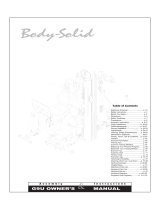Page is loading ...

Welcome to a personalized fitness experience for your members
DISCOVERY™ BENCHES AND RACKS
GETTING STARTED GUIDE
Thank you for purchasing Precor equipment. For complete operational instructions and troubleshooting, view the product information at
www.precor.com.
You can find English-language workout and training videos on our Education page at
www.precor.com/education
, or visit
our PrecorInc channel on
www.youtube.com
.
Make sure your trainers regularly read our blog (select languages) at
www.precor.com
for MORE ideas about fitness
routines and advice from trusted industry experts.
User Safety
•
Read all of the warnings on the equipment and obtain instructions on the use of the
equipment.
•
DO NOT exceed maximum weight capacities.
•
If you do not understand how to operate a piece of equipment, ask someone from the facility
such as a trainer to demonstrate how to use it and to explain any safety instructions.
•
Visually ensure lifting bar catch rods are fully engaged and seated in their hooks before
releasing the load and exiting the equipment.
•
Make sure adjustment features are set securely in place or locked securely in position.
•
ALWAYS set both bar catches when available on a equipment.
•
PROPER bar catch height depends on the exercise performed.
•
Make sure all weight and weight plates are properly secured before and after you execute
a lift.
•
Use proper form and technique when you lift weights.
•
If you're doing an exercise that involves pressing a weight above your head or positioning
a bar over your body, always use a spotter.
•
ALWAYS make sure the weight plates are fully engaged and safety collars are secured.
General Guidelines
F
or the best results on your exercise program, consult with a certified fitness professional.
•
Start your exercise program conservatively and always warm up your muscles before
exercising.
•
Perform light cardiovascular exercise or calisthenics for several minutes, followed by active or
dynamic stretching, to prepare your body.
•
Start with a weight for each exercise that is easily performed for the full range of your motion.
•
Focus on good posture and engaging your abdominal, back and gluteal muscles to stabilize
your body during all exercises.
•
Pay attention to how your body feels during and after training, and adapt your program
accordingly.
•
If an exercise feels too easy, increase your training load or change your training position.
•
If an exercise feels uncomfortable, modify your exercise by changing the training load or
movement pathway.

CAUTION Before beginning any fitness program, see your physician for a thorough medical examination.
T
raining and Exercising
DBR Getting Started Guide | P/N CW39221-101 rev A, ENU
©2015 Precor Incorporated | October 2015
There are many ways to structure your training program. Two of the most popular formats involve split workouts (training dierent
areas of the body on dierent days in order to provide adequate work and rest periods for dierent muscle groups) and circuit workouts
(training dierent areas of the body back-to-back in quick succession for total body conditioning and higher calorie burn).
Split Workout Suggestions
Exercises isolating the same muscle or area of the body (arms, upper body, back, etc.) should be grouped and performed together,
followed by a day of rest for these muscle groups. At the end of a training session, exercisers should stretch their exercised muscles to
increase
flexibility and reduce soreness.
1. Exercise every other day, up to three times a week. One to two days of rest enable the body to recover from the previous
workout.
2. Alternate your daily workouts. One day isolate the upper body exercises, and the next day perform the lower body exercises.
Circuit Training Workout Suggestions
Perform 8-10 dierent exercises back-to-back with minimal rest. The order of the exercises is important. Make sure to alternate
exercises that challenge opposing muscles groups to allow for adequate rest time of each muscle. For best results, complete the entire
circuit 2-3 times.
Program Suggestions
One REPETITION is one complete movement from the starting position, through the full range of motion, and back to the starting
position.
One SET is a series of continuous repetitions, ideally 8-15 repetitions. As a general rule, the lower the number of repetitions
performed (8-10), the heavier the weight used. While heavy resistance increases muscular strength, the full range of motion is
necessary to achieve maximum muscle development and eciency.
Rest just long enough between each set of repetitions to catch your breath. Work up to 3 or 4 sets for each isolated exercise.
When you can perform the desired number of repetitions at a given weight, increase the resistance.
For equipment with a bar catch, use the following instructions to adjust the bar catch height.
To adjust the bar catch height:
1. Remove weight from lifting bar.
Note For squats, perform the exercise and determine your lowest comfortable
position without your body contacting the floor. For other exercises, perform the
movement and determine the lowest point of bar travel that is comfortable without
the bar contacting your body.
2. Position both bar catches to stop the bar at this point. Ensure that they are completely
seated on the upright slots.
3. Make sure the weight plates are fully engaged and safety collars are secured.
General Exercise Guidelines
/







